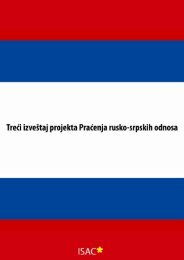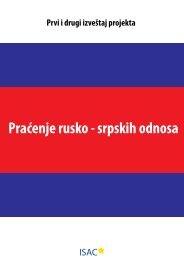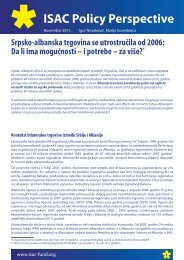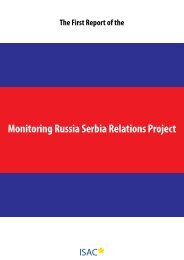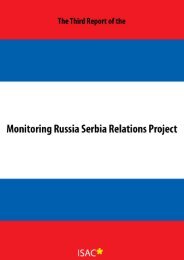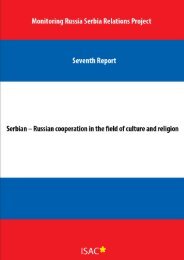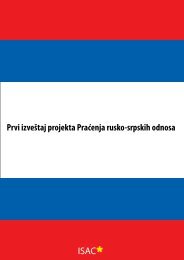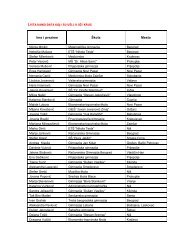the process of security sector reform - ISAC Fund
the process of security sector reform - ISAC Fund
the process of security sector reform - ISAC Fund
Create successful ePaper yourself
Turn your PDF publications into a flip-book with our unique Google optimized e-Paper software.
Angus Morris REFORM OF THE ARMED FORCES<br />
Angus Morris REFORM OF THE ARMED FORCES<br />
However, <strong>the</strong> term “armed force” could include use <strong>of</strong> armed force by many<br />
actors who may not be “all right”. These include those with or without authority,<br />
who have arms, and use or intend to use armed force for <strong>the</strong>ir own aims, ra<strong>the</strong>r<br />
than those <strong>of</strong> a country, or for providing external and internal <strong>security</strong> for <strong>the</strong><br />
citizens <strong>of</strong> that country.<br />
There are many agencies that might be are authorised to use armed force,<br />
including: armed forces; police; paramilitary forces; gendarmeries; presidential<br />
guards; intelligence and <strong>security</strong> services (both military and civilian); coast<br />
guards; customs authorities; reserve or local <strong>security</strong> units(civil defence forces,<br />
national guards, militias). <br />
In modern day usage, <strong>the</strong>se would be collectively known as core <strong>security</strong> actors,<br />
within <strong>the</strong> broader framework <strong>of</strong> <strong>the</strong> <strong>security</strong> <strong>sector</strong>. To complete <strong>the</strong> picture,<br />
<strong>security</strong> management and oversight bodies, justice and law enforcement<br />
institutions and non-statutory <strong>security</strong> forces should be included.<br />
So, while <strong>the</strong> term Armed Forces remains in regular international use today,<br />
<strong>the</strong>ir context and <strong>the</strong> implications <strong>of</strong> <strong>the</strong>ir use have been brought much more<br />
sharply into focus as a result <strong>of</strong> concerns over <strong>the</strong>ir misuse. Therefore, within<br />
this analysis, armed forces <strong>reform</strong> will be examined within <strong>the</strong> environment <strong>of</strong><br />
<strong>the</strong> <strong>security</strong> <strong>sector</strong> as a whole. This requires considering not just <strong>the</strong>oretical and<br />
political concepts, challenges and experiences <strong>of</strong> <strong>reform</strong> but also why <strong>reform</strong><br />
might be needed in <strong>the</strong> first place.<br />
THEORETICAL AND POLITICAL<br />
CONCEPTS OF REFORM<br />
Reform, or review or transformation, now lives within <strong>the</strong> world that is Change<br />
Management. Here <strong>the</strong>re is much in <strong>the</strong> way <strong>of</strong> study and advice available to all.<br />
However, many who have considered defence <strong>reform</strong> in <strong>the</strong> past have ignored<br />
<strong>the</strong> well-founded and generally accepted <strong>the</strong>oretical principles <strong>of</strong> what tended to<br />
be considered, unfavourably, as management-speak.<br />
<br />
Understanding and Supporting Security Sector Reform, United Kingdom Department for International<br />
Development, February 2002<br />
The following general principles are internationally recognised as essential steps<br />
in successful Change Management:<br />
• Visible, dynamic top-level support for change<br />
• A clearly stated vision towards which <strong>reform</strong> will reach<br />
• A plan <strong>of</strong> how to get from where you are to where you want to be<br />
including methods for measuring and tracking delivery<br />
• A dedicated team <strong>of</strong> authorised experts who will oversee <strong>the</strong> plan<br />
• Individuals who are accountable for <strong>the</strong> delivery <strong>of</strong> <strong>the</strong> plan constituent<br />
elements<br />
• Identifiable <strong>process</strong>es whereby all involved parties can influence change<br />
• Regular updates <strong>of</strong> progress, made known at <strong>the</strong> early stages <strong>of</strong> change<br />
• Essential infrastructure and funding available and sustained during<br />
change<br />
• A plan for discussion and finalisation <strong>of</strong> proposals for change<br />
• Continuous visible engagement <strong>of</strong> top-level management throughout <strong>the</strong><br />
<strong>process</strong><br />
• Certainty that <strong>the</strong> change will happen and that it is <strong>the</strong> right thing to do<br />
These <strong>the</strong>oretical management concepts translate directly into modern-day practice<br />
in Armed Forces Reform. Bearing in mind <strong>the</strong> need to look at <strong>the</strong> wider <strong>security</strong><br />
<strong>sector</strong> context, <strong>the</strong>se become:<br />
• Public identification <strong>of</strong> <strong>the</strong> reasons for defence <strong>reform</strong><br />
• Why do we need to <strong>reform</strong> <strong>the</strong> Armed Forces?<br />
• What has changed elsewhere that generates <strong>the</strong> need for<br />
change?<br />
• What benefit is <strong>reform</strong> designed to bring about?<br />
• What would be <strong>the</strong> result <strong>of</strong> not making changes now?<br />
• Summarised as a Vision<br />
• Nomination <strong>of</strong> a leader <strong>of</strong> change<br />
• Clear and sustained support for <strong>the</strong> <strong>reform</strong> <strong>process</strong><br />
42 43



